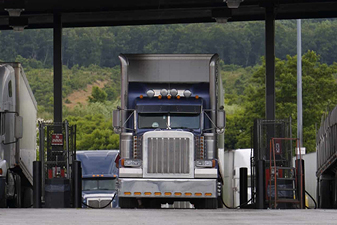|
By Dean Croke, DAT Freight & Analytics
Despite the Biden Administration’s efforts to lower diesel and gasoline prices—including massive releases of crude from the Strategic Petroleum Reserve (SPR)—it’s hard to imagine stability at the pump any time soon.
With diesel averaging almost $5.60 a gallon heading into Memorial Day weekend, supply chain managers and trucking companies are preparing for another summer of volatility and extreme pressure to control transportation costs.
Fuel prices have spiked before, notably in 2004, after Hurricane Katrina, and again during the oil-price boom of 2008. They hovered around $4 a gallon from 2011 to the middle of 2014.
Truckload rates then were much lower than they are today. Most trucking companies will pull through, but they have very few remedies to counter fuel price swings. Let’s look at three of them.
Fuel surcharges
Trucking companies set their rates to cover their operating costs plus a profit margin. A fuel surcharge helps carriers protect themselves against losses when the cost of fuel increases substantially during the life of the contract.
Every trucking company has its own method for calculating a fuel surcharge and most are transparent about the formula they use. The surcharge usually appears on the freight invoice as a separate fee, making it easy for the shipper to identify.
It’s a different story for truckers on the spot market.
Spot rates are quoted for a single job so there’s no need to add a separate surcharge or adjust the rate every time there’s a change in the price of diesel. This means truckers on the spot market must be extra vigilant about negotiating a rate with a freight broker that will cover their fuel costs during the trip. These truckers tend to be small fleets and independent owner-operators who pay retail prices for fuel and don’t have bulk purchasing or other programs that can help them manage their fuel expenses.
Whether a carrier is moving contract freight or spot, skyrocketing fuel costs will hurt its cash flow. Once a truck is fueled up and the freight has been delivered, it might take 30 days or more for the carrier to get paid. By then, who knows how much it costs to refill the tank?
Fuel efficiency
As diesel prices increase, carriers focus on operating more efficiently. They get selective about the loads they accept, especially if they involve facilities that are out of the way or notorious for
|

delays at gates or docks. They avoid lanes into markets where freight is scarce or fuel is expensive. They want to keep the truck loaded and moving.
Todd Amen of ATBS, a business consulting firm for small fleets and owner-operators, said recently that slowing down and reducing idling, which burns about a gallon per hour, can save around $10,000 a year. That’s equivalent to 5,000 revenue-producing miles at $2 a mile or roughly two weeks’ work.
Lower speeds can reduce aerodynamic drag and increase fuel efficiency. But road speed is tied to how much distance the truck can travel and therefore how much revenue it can produce during a duty cycle. When you’re paid by the mile or by the load, and driving time is regulated by an electronic logging device (ELD), slowing down isn’t always as practical or feasible as it sounds.
Park the truck
Some independent owner-operators may choose to take a break and not haul loads for a few months. Those who jumped into for-hire trucking from a line of work like farming or construction can slip back into those vocations. Others will go back to driving for a large fleet as a company employee or a leased owner-operator.
Looking at the bigger picture, the cost of fuel isn’t the only issue for carriers. They’re paying more for driver wages, tires, insurance, repairs, and parts (if they can get them). While fuel costs will eventually even out, other costs will remain high and must be taken into consideration when predicting rates.
The industry sector bearing the greatest burden of fuel prices is new-to-the-market owner-operators who bought used trucks at record-high prices. When those owner-operators go out of business, those trucks will be sold or repossessed and go to auction.
For those of us who have been around trucking for a while, the boom-bust cycle is a familiar one. But high fuel costs make this trend different. Even well-run carriers and owner-operators are running on fumes and looking for relief.
Dean Croke is the principal industry analyst at DAT Freight & Analytics, which operates the industry’s largest load board network and the DAT iQ data analytics service. Dean publishes weekly market updates on truckload freight at dat.com.
|


